Eastern Skunk Cabbage, a Sign of Spring
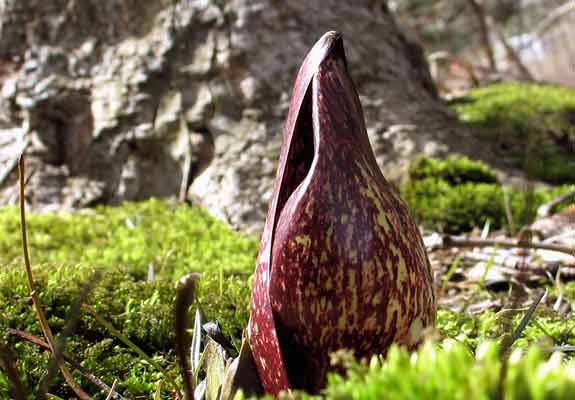
A Plant With Eau-de-skunk
A Quick Note Before You Begin: Many of you have commented that my spelling and grammar is often atrocious, and that is inexcusable for an educator! So, I'm taking steps to remedy the situation. I wanted to say WELCOME to Sally Parker and Anne Littlewolf, my new editors for the blog! Of course, all mistakes are my own, but they are going to try to help me on that score. Thank you ladies and welcome on board!
On To The Smelly Blog Post For Today!
One of the early harbingers of Spring, even before all the snow melts, is skunk cabbage. The variety I'm going to talk about today is the Eastern skunk cabbage (Symplocarpus foetidus). There is also a related western variety. Eastern skunk cabbage grows East of the Mississippi, into New England, and as far south as Tennessee (where it is protected) and South Carolina. It is one of the first buds to appear in Spring, and one of the first bright green leaves you will see with the spring leaf-in.
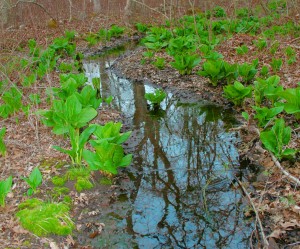
Eastern skunk cabbage is a low growing and soft bodied perennial herb that you can find around low lying streams and wetlands. It is in the Araceae family, along with lilies and the familiar Jack-in-the-pulpit (when you see the flower, you'll know why). In the early spring, it sends out a flower bud called a SPATHE (4-6" tall) that grows up through the ground. Inside the flower is a SPADIX (2-5") which is a fleshy stem of flowers coming up through the center (think of your typical lily). The skunk cabbage flower is a mottled maroon color with whitish-green streaks, a spiral curvature, and a noticeable hood. The spadix (flower stalk) is whitish yellow. The flowers on the spadix are tightly packed. If you look closely, they don't have petals, but modified sepals and reproductive bits sticking out.

The spadix releases a rotting meat scent that attracts early spring pollinators such as flies, bees, and carrion beetles which emerge earlier than most butterflies and moths. You know a plant is rather pungent when its Latin name includes foetidus (fetid= rank or smelly). Once pollinated, the seeds of the skunk cabbage look like round balls (2" diameter) about the same color as the flower petals. The balls have multiple berry-like seedlets that eventually fall apart from each other in late summer. Skunk cabbage doesn't spread through any other means than its fruits.

The leaves of skunk cabbage, also, make it a special stinker. After the flower blooms and is pollinated, the leaves begin to emerge. They are bright green and quite large (15-20" long), whirling out of the ground in a rosette pattern. When broken or bruised, the leaves emit a skunk-like smell. This smell is not harmful to humans, but it is thought to be an insect or herbivore deterrent. You also don't want to eat the leaves because they will cause instant swelling of the mouth and inflammation of the digestive tract. Leave this one alone!
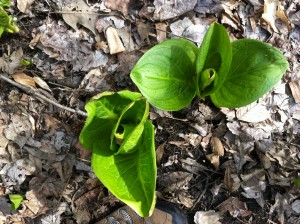
Skunk cabbage and few other species of Araceae, such as dead-horse arum, voodoo lily, and the carrion flower (notice a trend here with smelly flowers?), are all THERMOGENIC plants. Thermogensis means that during cellular respiration (when they photosynthesize and convert sunlight into food) the plants use some of their ATP, or energy, to produce heat up to 60-80 degrees Fahrenheit. There's quite a bit of speculation about why this is. For Eastern skunk cabbage, the advantage is that the heat production allows the flower to emerge very early in the Spring even if there is snow on the ground. They can even melt the snow around the bud to emerge bright and shining through a snow drift.
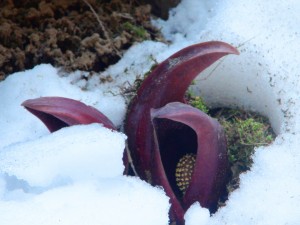
Skunk cabbage may use thermogenesis because its flower is not able to develop without being at a certain temperature (and there's some suggestion that pollen can't generate a pollen tube for fertilization without heat). However, the Eastern skunk cabbage is unique because it is a lily that it lives in places that have snow and cold. Most lilies are found in tropical forests. Why would tropical lilies need to make themselves warm? It's thought that thermogenesis, in skunk cabbage and other lilies, helps to heat the "stinky-corpse-oil" scent (like Aunt Bertha's potpourri diffuser) and to diffuse the smell for pollinators. I'll leave it up to you which smells worse. You can read more in the Peter v. Minorsky's paper on Plant Thermogenesis and Thermoregulation in the Plant Physiology journal if you're curious.
As if all that wasn't enough to make the skunk cabbage a fascinating plant, let's look at the root system. The flowers and leaves of E. skunk cabbage grow from a thick stem that comes up from a massive rhizome or root system under ground. It's nearly impossible to dig one completely up. The roots appear to be wrinkled and branching. They are known as contractile. This means that as the roots grow they act like fingers, contracting the plant deeper and deeper into the earth and pulling the plant downward. These roots may go many feet deep into the soil. The older the plant, the deeper its roots are in the soil. This adaptation is beneficial for wetlands or stream-sides where the plants may be washed away if their root system isn't strong and deep. These deep roots also act as a "root cellar", storing nutrients after the leaves decay in later spring.
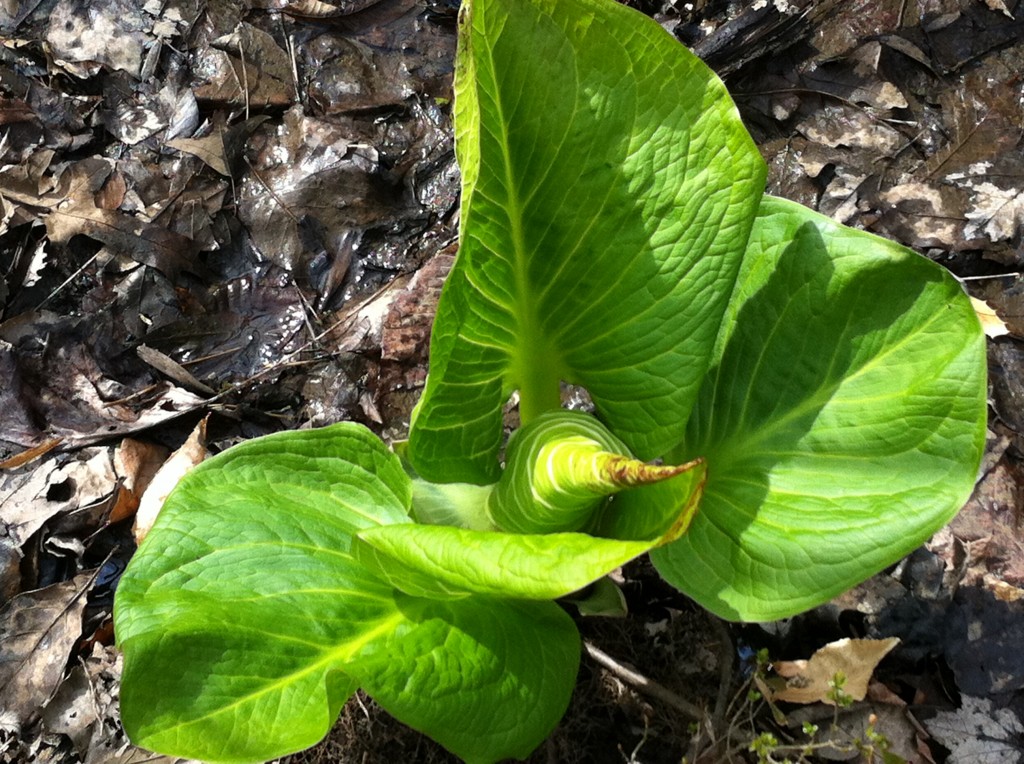
Skunk cabbage doesn't even decay like other plants. Around late June or July, the leaves begin to "slime" apart and get holes in them. It appears that they are dissolving into the landscape. This may be a form of autolysis or self digestion that allows them to re-absorb water and nutrients into their root system.
Skunk cabbage is a fascinating plant that deserves a second look. Although it may be smelly, it's also a marked harbinger of Spring. Take a look next time you're out in the woods.

